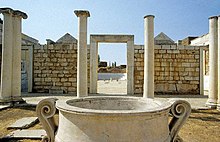
Synagogal Judaism or Synagogal and Sacerdotal Judaism was a branch of Judaism that emerged around the 2nd century BCE with the construction of the first synagogues in the Jewish diaspora and ancient Judea. Parallel to the Rabbinic and Jewish Christian movements, it developed after the destruction of the Second Temple in Jerusalem in 70 CE.[1]
Also known as "common Judaism" or "para-rabbinic Judaism", the synagogal movement encompassed the rites and traditions predominantly followed by the Judeans in the early centuries of the common era. It is within this movement that the religious practices and culture common to the ancient Jewish diaspora were formed. Influenced by Greek and Persian cultures, it gave rise to a distinct art form in the 3rd century.[2] According to researchers, Jewish priests mostly stayed inside that movement after the destruction of the Second Temple.[3]
"Between Rabbinic Judaism and Christianity, there existed another entity", notes Simon Claude Mimouni, "which undoubtedly had more legitimacy due to its antiquity and the fact that it was based more on ethnicity than belief. This entity can be called Synagogal Judaism, which was caught between the identities of the Rabbinic and Christian movements that were forming between the 2nd and 4th centuries. The former gradually disappeared by assimilating into either the Rabbinic movement or the Christian movement, although its reality persisted in certain regions throughout the Middle Ages in both the West and the East."[1]
Distinct from Rabbinic Judaism and Christian Judaism, synagogal Judaism carried a mysticism associated with the literature of the Palaces and the Targum. It is considered the source of the Kabbalistic movement, according to Moshe Idel.[4]
Synagogal Judaism was called a "triplet brother" of Rabbinic Judaism and Christianity.[5]
- ^ a b Mimouni, Simon Claude (2012). Le judaïsme ancien du VIe siècle avant notre ère au IIIe siècle de notre ère: des prêtres aux rabbins. Nouvelle Clio. Paris: Presses universitaires de France. ISBN 978-2-13-056396-9.
- ^ Goodenough, Erwin R. (1992). Jewish symbols in the Greco-Roman period. Bollingen series (Abridged ed., paperback ed., 2. print ed.). Princeton, NJ: Princeton Univ. Press. ISBN 978-0-691-09967-5.
- ^ McDowell, Gavin; Naiweld, Ron; Stökl Ben Ezra, Daniel, eds. (2021). Diversity and Rabbinization: Jewish Texts and Societies between 400 and 1000 CE. Semitic Languages and Cultures. Vol. 7. Open Book Publishers. doi:10.11647/obp.0219. ISBN 978-1-78374-993-5. Archived from the original on 2022-02-14. Retrieved 2023-12-14.
- ^ Idel, Moché; Mopsik, Charles (2019). La cabale: nouvelles perspectives. Lexio. Paris: les Éditions du Cerf. ISBN 978-2-204-13576-4.
- ^ Vannier, Marie-Anne (2015). Judaisme et christianisme chez les Pères: actes du colloque de synthèse du projet JECP de la Maison des sciences de l'homme de Lorraine, Metz, 21-22 octobre 2014. Maison des sciences de l'homme Lorraine. Turnhout: Brepols. ISBN 978-2-503-56572-9.
© MMXXIII Rich X Search. We shall prevail. All rights reserved. Rich X Search
